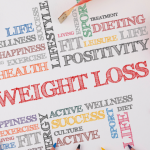Calories represent the energy content in food. Every cell in the body needs this energy to function, similar to how fuel powers a car. During digestion, the body breaks down food and releases this energy, which powers essential functions like breathing, thinking, walking, sleeping, and digestion.
However, the body may only require some energy after some time. Excess calories are stored—primarily as fat and carbohydrates—to be used later. When engaging in energy-intensive activities such as exercise or studying, these stored calories become the energy source needed to sustain those efforts.
When calories consumed exceed those burned, the excess is stored as fat, leading to weight gain. A calorie deficit, where more calories are burned than consumed, prompts the body to use stored fat for energy, resulting in weight loss.
Determining a Healthy Calorie Deficit
A daily calorie deficit of around 500 calories is recommended for steady and sustainable weight loss. This generally supports a weight loss rate of about 1 pound per week. Typically, this deficit should align with a minimum intake of 1,200 to 1,500 calories per day for women and those assigned female at birth and 1,500 to 1,800 calories per day for men and men. Consuming fewer calories than these guidelines can be unhealthy, so it’s essential to consult with a healthcare provider to determine the proper intake for your needs.
It’s also worth noting that a calorie deficit is only sometimes necessary. It’s only required if weight loss is a goal, whether for health or other personal reasons. Always consult a healthcare provider before starting any weight loss plan, especially if you have underlying health conditions.
Strategies for Achieving a Calorie Deficit
Creating a calorie deficit to support weight loss involves balancing calorie intake with energy expenditure. First, identify your daily calorie needs by calculating how many calories your body requires to maintain weight. Once this baseline is established, reducing calorie intake or increasing physical activity will help create the deficit necessary for weight loss.
Here’s a practical example: if your body requires around 2,000 calories per day and your goal is to lose about 1 pound per week, you could create a deficit of 500 calories each day by consuming only 1,500 calories. Alternatively, you could increase your physical activity to burn an extra 500 calories daily, maintaining your intake at 2,000 calories but achieving the same 500-calorie deficit.
Combining both methods is also effective. For instance, increasing daily exercise to burn 200 calories while reducing intake by 300 can still create a 500-calorie deficit. Adapting the approach that best suits your lifestyle and preferences often leads to the most sustainable results.
Calorie needs vary based on age, sex, height, weight, and exercise habits. A calorie calculator can provide a personalized estimate of daily requirements. Always consider consulting a healthcare provider before making significant dietary or exercise changes.
Factors That Influence Calorie Requirements
Calorie needs aren’t one-size-fits-all; they depend on various factors. Your metabolic rate, or the rate at which your body burns calories at rest, plays a significant role. This rate can differ widely from person to person, influencing how many calories are required to maintain weight. Health conditions also affect calorie requirements. For example, hypothyroidism slows metabolism due to an underactive thyroid gland, while conditions like Cushing’s syndrome, caused by excessive cortisol, can also reduce metabolic rate.
While creating a calorie deficit is essential for weight loss, an excessive deficit can be harmful, leading to side effects such as constipation, dehydration, fatigue, headaches, nausea, and even mood changes like irritability from hunger (“hangry”). An overly large calorie deficit can also be challenging to maintain and may hinder long-term success. A moderate, sustainable calorie deficit is generally more manageable and better for overall health.
Creating an Effective Diet Plan for a Calorie Deficit
There isn’t a single approach to creating a calorie deficit, so flexibility is critical. One simple yet effective method is to replace sugar-sweetened drinks with water, a calorie-free option that can reduce your daily intake significantly. By swapping out soda, sports drinks, energy drinks, sweetened teas, and fruit juices (which can contain 60 to 120 calories per 6 ounces) for water, you’re cutting calories without sacrificing satisfaction. Staying hydrated helps you adapt to a reduced-calorie diet, as thirst can sometimes be mistaken for hunger. Reaching for a glass of water instead of a snack can help curb unnecessary calorie intake.
The DASH and Mediterranean diets, known for their balanced and nutrient-dense foods, can help achieve a calorie deficit. These diets emphasize fresh fruits, vegetables, lean proteins, whole grains, nuts, and seeds, which provide sustained energy and satiety. This can make it easier to manage hunger and reduce the urge to snack between meals. Consistently monitoring portions and planning meals can also make a big difference. For personalized guidance, consulting with a registered dietitian can help you develop strategies for maintaining a healthy calorie deficit tailored to your needs.
Additional Tips for Maintaining a Calorie Deficit
- Curb Simple Carbs: Opt for high-fiber complex carbohydrates like brown rice, whole grains, and fresh fruits and vegetables instead of low-fiber, high-carb options like white bread, white rice, and regular pasta. Complex carbs promote longer-lasting fullness, which can help prevent unnecessary snacking or overeating.
- Go Light at Restaurants: Avoid oversized portions and high-fat dishes when dining out. Start your meal with a small salad or a light soup to fill you up and prevent overeating later. Choose fresh fruit or sorbet for dessert to satisfy your sweet tooth without adding unnecessary calories.
- Read Food Labels: Always check food labels to understand calorie counts and sugar content better. This can help guide your choices and ensure you’re not unknowingly consuming more than you intend. For instance, some low-fat yogurts may contain higher sugar levels than others, which could affect your calorie intake.
- Limit Prepackaged Meals: Meals often contain excess fat, sugar, and salt. By preparing meals from whole foods, you gain more control over your eating, helping you make healthier, lower-calorie choices while ensuring proper nutrition.
Best Calorie-Deficit Breakfast Options
For a calorie-deficit breakfast, it’s essential to include foods rich in fiber and protein, as they help keep you full longer, reducing the temptation to snack. Here are some great options:
- Plain Greek Yogurt with Berries, Nuts, or Seeds: Greek yogurt is high in protein and low in calories. Add fresh or frozen berries for antioxidants, and sprinkle with nuts or seeds for healthy fats and fiber.
- Egg or Egg White Omelet with Vegetables: A two—or three-egg (or egg white) omelet with mixed vegetables like spinach, peppers, and onions is packed with protein and fiber. Add a quarter-cup of feta or low-fat cheese for added flavor without too many calories.
- Protein-Packed Smoothie: Blend half a cup of Greek yogurt or a scoop of protein powder with a cup of frozen fruit (like berries or banana), a handful of leafy greens (such as spinach or kale), and low-fat or unsweetened milk. This smoothie combines protein, fiber, and essential vitamins while keeping you full until your next meal.
Physical Activity for a Calorie Deficit
While adjusting your diet significantly creates a calorie deficit, combining diet changes with physical activity can enhance weight loss and help you maintain results. Here’s how to incorporate exercise into your calorie-deficit plan:
- Aim for 30–45 Minutes of Exercise: Research shows that exercising at least 30 minutes most days a week can boost your calorie deficit. For long-term weight management, 45 minutes or more might be even more effective. You don’t have to complete it all at once—smaller, 10-minute bursts of activity throughout the day work just as well.
- Moderate Activity Options: If you’re looking for moderate exercises, consider activities like walking around the block, gardening, or lawn mowing. These activities help burn calories and keep you active without overexertion. Biking and swimming are also excellent low-impact options.
- Vigorous Exercise for Greater Impact: For a higher calorie burn, engage in more vigorous exercises such as running, heavy yard work, or high-energy activities like Zumba. These activities elevate your heart rate and burn more calories.
- Strength Training for Weight Loss: Incorporating strength training at least twice a week is crucial for building muscle, which in turn boosts metabolism and helps with weight loss. You can use weights, resistance bands, or your body weight (push-ups or planks) to build muscle.
- Consult with a Doctor: If you’re over 50, have underlying health conditions, or are pregnant, consult your doctor before starting a new exercise routine. This is especially important if you’re on medications that affect your metabolism.
Remember, even if weight loss isn’t your primary goal, regular physical activity supports overall health, prevents weight gain, and helps maintain weight loss long-term.
Other Ways to Reach a Calorie Deficit
Achieving a calorie deficit for weight loss can be complicated by underlying factors like eating disorders, such as binge eating disorder. These conditions often involve complex relationships with food; addressing them requires more than modifying eating habits. Here are some approaches to help:
- Therapeutic Support: If eating disorders are preventing you from reaching a calorie deficit, collaborating with a therapist can be highly beneficial. Cognitive Behavioral Therapy (CBT), motivational interviewing, and acceptance and commitment therapy (ACT) are all therapeutic methods that can help you reframe thoughts about food and exercise, fostering healthier relationships with eating.
- Behavioral and Mindfulness Techniques: These therapies address emotional triggers, thought patterns, and behaviors that may lead to overeating or unhealthy food choices, making it easier to maintain a calorie deficit.
- Technology Assistance: Smartphone apps can be valuable tools for tracking food intake, setting exercise reminders, and offering motivation. These apps provide a structured way to monitor your progress and stay accountable to your goals, offering guidance to keep you on track with your calorie deficit efforts.
Incorporating these methods into your routine may support your journey toward a calorie deficit and help you maintain a sustainable, healthy approach to weight management.
Potential Calorie Deficit Risks
While creating a calorie deficit can help with weight loss, it’s essential to approach it healthily. If done improperly, a calorie deficit can lead to several health risks:
- Too Little Nutrition: Cutting too many calories or failing to choose nutrient-dense foods can deprive your body of essential vitamins and minerals. For example, insufficient calcium intake can negatively impact bone health, while inadequate protein or fiber intake may hinder overall body function.
- Low Energy: A significant calorie deficit can slow down your metabolism as your body tries to conserve energy. This may leave you feeling sluggish, cold, and tired, and it can even lead to digestive issues like constipation.
- Brain Drain: Your brain relies on calories for proper function. Cutting too many calories may impair cognitive function, affecting concentration, memory, and overall mental clarity.
- Gallstones: Rapid weight loss due to extreme calorie restriction can increase the risk of developing gallstones, which are painful and may require medical intervention.
- Disordered Eating: Focusing too much on dieting and food restrictions can develop an unhealthy relationship with food. It may foster negative emotions or lead to disordered eating patterns, such as binge eating or restrictive behaviors, which can be harmful both physically and mentally.
To avoid these risks, it is crucial to create a balanced, sustainable calorie deficit that still provides adequate nutrition and supports overall well-being.
Can You Build Muscle in a Calorie Deficit?
Yes, building muscle while in a calorie deficit is possible, but there are essential considerations to remember. Building muscle requires strength training exercises, which need energy—calories. You’ll need to maintain a slight calorie deficit that allows fat loss while providing enough power for muscle-building workouts to achieve both fat loss and muscle gain.
Your calorie needs increase on workout days, so it’s essential to plan accordingly. Consume enough protein to support muscle growth. To maintain a calorie deficit while preserving muscle mass, focus on cutting calories from carbs and fats rather than protein.
A calorie deficit is critical for weight loss, but it’s important not to go too far. An overly large deficit can hinder your ability to maintain energy levels and build muscle, posing risks to your health. Instead, aim for a modest deficit that enables gradual and sustainable weight loss while preserving muscle mass.



